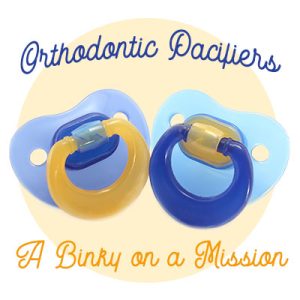Orthodontic Pacifiers: A Binky on a Mission
Posted on August 18th, 2023
 Parents face many decisions, even before their baby makes an appearance—but once that bundle of joy arrives, one important choice is whether to use a pacifier. Babies have a natural reflex to suck their thumbs, fingers, pacifiers, or other objects to help them feel more secure, to soothe them, or to lull them to sleep. If you decide your little bundle of joy needs a binky for a bit, Dr. Chad Johnson recommends an orthodontic pacifier.
Parents face many decisions, even before their baby makes an appearance—but once that bundle of joy arrives, one important choice is whether to use a pacifier. Babies have a natural reflex to suck their thumbs, fingers, pacifiers, or other objects to help them feel more secure, to soothe them, or to lull them to sleep. If you decide your little bundle of joy needs a binky for a bit, Dr. Chad Johnson recommends an orthodontic pacifier.
What is an Orthodontic Pacifier?
Orthodontic pacifiers are specifically designed to help alleviate misaligned teeth and orthodontic issues as baby teeth come in. The nipple of an orthodontic pacifier supports the shape of the developing jaw and palate. When the baby sucks, the orthodontic pacifier mimics the shape of a mother’s nipple, reducing pressure on gums and developing teeth and promoting a natural sucking motion.
Some orthodontic pacifiers are even constructed to feel soft enough to avoid irritation of their delicate baby skin. Research indicates an ordinary round-shaped binky is more likely to result in open bite and overbite problems than an orthodontic one. However, the best way to prevent dental damage is limiting pacifier use altogether and banishing the binky after the Baby turns one—even if the pacifier is orthodontic.
The Binky vs. The Thumb
Is one better than the other? The American Academy of Pediatric Dentistry thinks so. Why? Because the pacifier habit is easier to stop, whereas their thumb is always at easy access. The American Academy of Pediatrics recommends pacifier use when napping or sleeping during a Baby’s first year to help prevent the incidence of Sudden Infant Death Syndrome (SIDS), but binky use or thumb sucking past two to four years of age can negatively affect the shape of a child’s mouth and the way their teeth and bite align. If kids can ditch the pacifier or give up the thumb before their permanent front teeth come in, the probability of the bite correcting itself is more likely.
How to Wean Kids from the Pacifier
Most kids stop pacifier use or thumb-sucking on their own (peer pressure happens, even when you are only three—the struggle is real). Some kids are just not as binky-centric as others. Kids may stop as early as one year old or as late as four years old, and they tend to give up pacifiers before thumb-sucking. If you decide to wean gradually, consistency is key. Limit the use of pacifiers to naps and bedtime and keep every binky out of sight and out of reach. It usually doesn’t take more than a week for children to adjust to a pacifier-free routine.
If the weaning approach isn’t working and you decide the time has come for cold turkey, consistency is still the answer. If you go this route, your child cries for a long time and you give in anyway, you’ve just reinforced that crying will get them what they want. Here are some ideas that may help end the battle of the binky:
- Replace the pacifier with a new way to self-soothe. Help your child select a special toy to sleep with and hold for comfort.
- Discuss the change with your child in words that are appropriate for their age or developmental stage. Remind them they are a big kid and have the special toy now instead of the binky, so they no longer need one.
- Help your child use words or sign language instead of fussing. Saying or signing “sad,” “tired,” or “hungry” will fray everyone’s nerves much less than a wall of whining.
- Avoid replacing pacifiers with “sippy” training cups and let your child use a straw instead. Drinking from a straw strengthens the oral muscles used for speech.
- Give praise to the behaviors you want to encourage. If your child sleeps all night or makes it through a car ride without their pacifier, tell them what a great job they’re doing!
- Have your child’s dentist show them examples of what can happen to teeth if they don’t give up their pacifier, such as what overbites and braces look like.
If you have any questions about orthodontic pacifiers or need some support while your cutie gets the binky monkey off their back, contact Veranda Dentistry in Pleasant Hill and Johnston today!
The content of this blog is not intended to be a substitute for professional medical advice, diagnosis, or treatment. Always seek the advice of qualified health providers with questions you may have regarding medical conditions.


